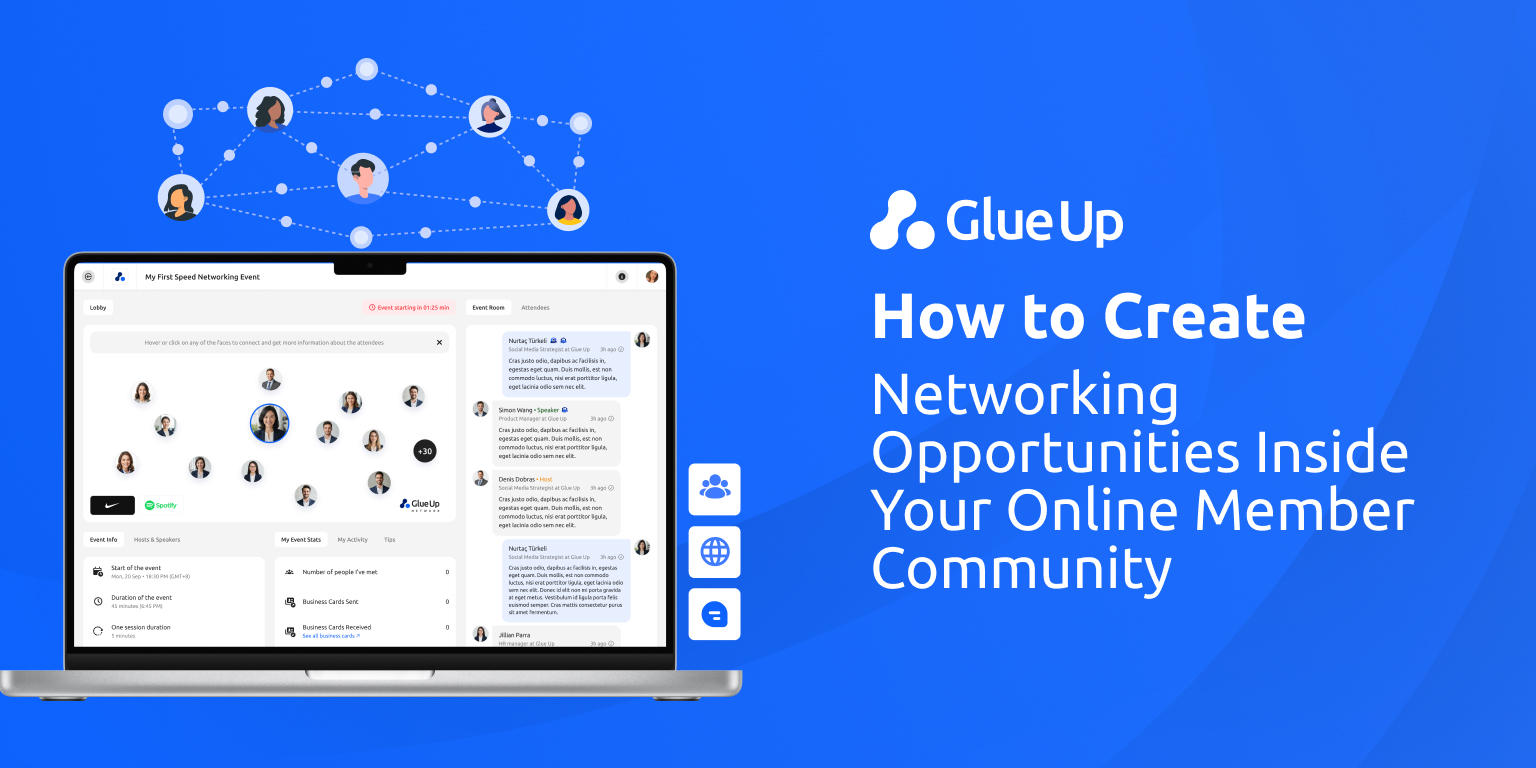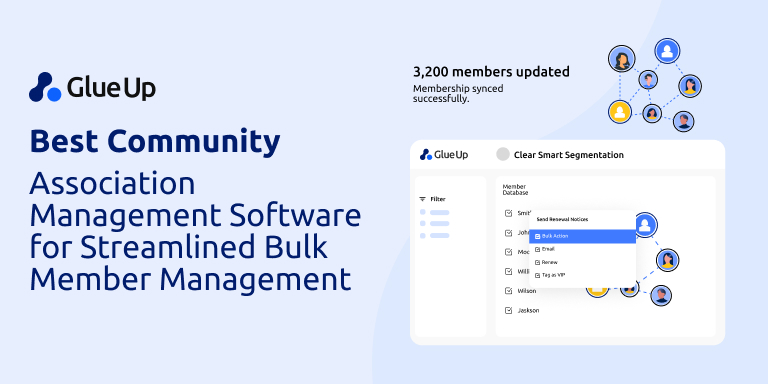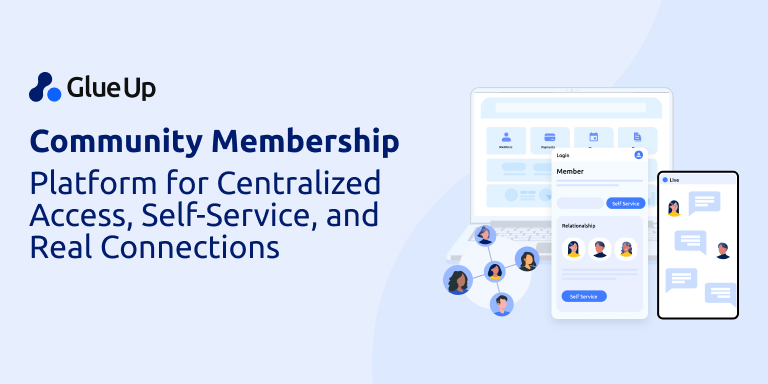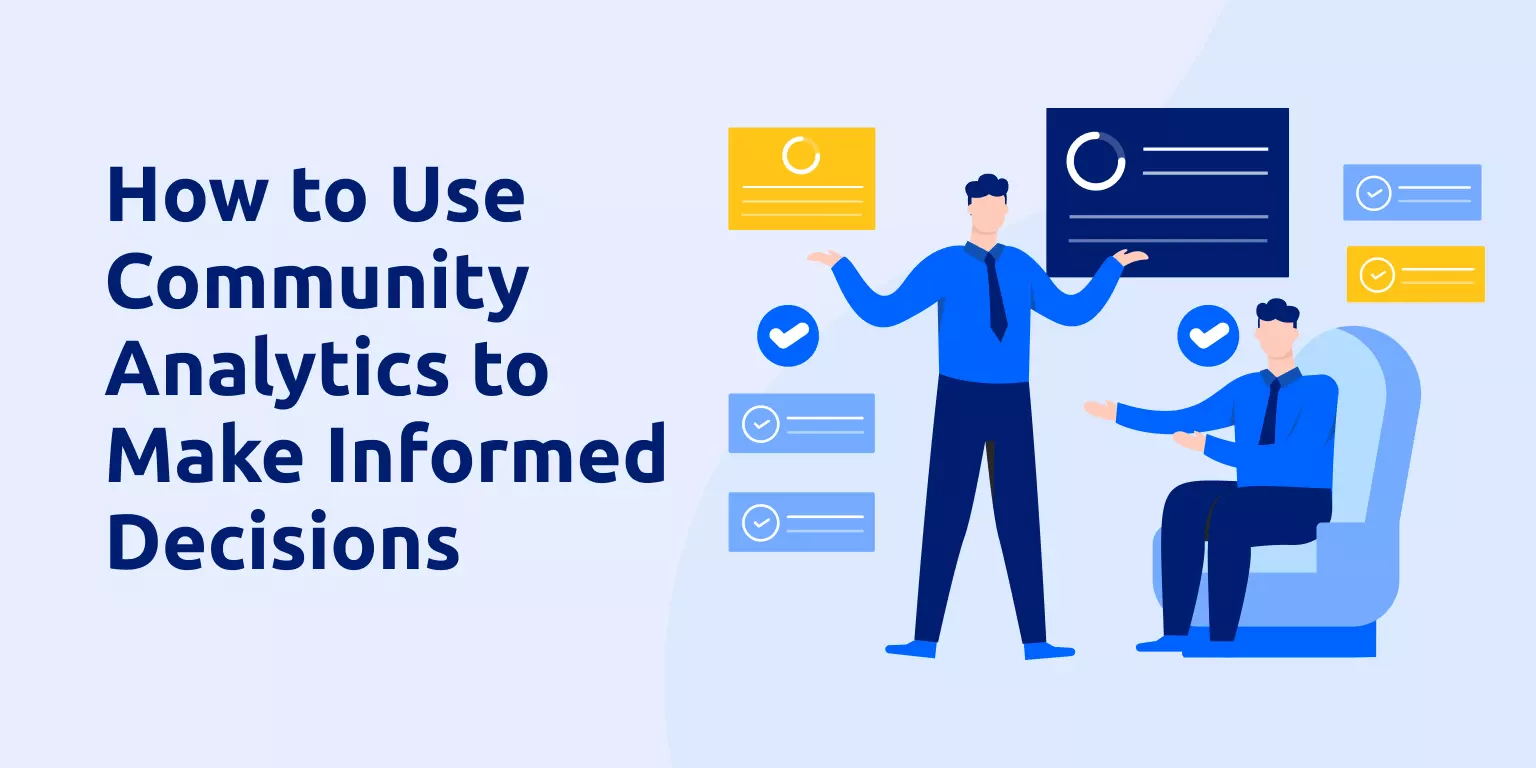
The emergence of social networks over recent years has led to the growth of online communities both in size and influence. These communities continue to transform how people with shared interests connect, share knowledge, and give feedback.
Recognizing the importance of online communities, many associations and other member-based organizations also have their own. After all, the best way for associations and other member-based organizations to grow is to
engage with their members online. They also need to understand how their members behave online so they can offer them the right features that ensure this continuous engagement.
This is where community analytics comes in.
Quick Reads
- What Is Community Analytics?
- Benefits of Data-Driven Decision-Making
- 6 Ways Community Analytics Ensures Data-Driven Decision-Making for Organizational Success
- Glue Up Community Management Software: An All-In-One Tool for Managing Your Communities
What Is Community Analytics?

Community analytics is the use of engagement and interaction data you’ve collected from your online community to help you understand its current health and performance. It covers the collection of relevant insights, the measurement of key community metrics, and the identification of patterns and trends in the data.
With an understanding of these deeper insights about your online community, you can, ultimately, make data-driven decisions.
Benefits of Data-Driven Decision-Making
Data-driven decision-making approach has proven to be a powerful solution for organizations that want growth. Research by Gartner projected that in 2023 more than 33% of large organizations will have analysts practicing decision intelligence, including decision modeling.
But how exactly can data-driven decision-making drive growth?
Unlike when decisions are based on assumptions or guesses, the data-driven approach utilizes data analysis techniques to help decision-makers gain deep insights. They get to understand general operations, user activity, and trends. With this in-depth understanding, decision-makers can develop accurate and precise solutions, predictions, and outcomes.
With data-driven decisions, execution also becomes smoother. This is because decision-makers have already factored in all possible risks and opportunities that come with a specific choice.
Data-driven decision-making also encourages more agility and adaptability. Decision-makers are constantly collecting and analyzing data, which helps them quickly identify any changes in market dynamics or consumer trends and respond promptly. Thanks to this agility, organizations maintain their competitive edge and stay ahead of the curve.
Finally, the data-driven decision-making approach goes hand-in-hand with measurable outcomes. Since your choices are based on actual data, you can easily tell their effectiveness by setting and continuously measuring KPIs.
Doing this will also help you identify strategies that require improvements for better results.
6 Ways Community Analytics Ensures Data-Driven Decision-Making for Organizational Success
Community managers can harness the benefits of community analytics to make data-driven decisions for organizational success. In this section, we’ll look at six ways analytics for communities ensures data-driven decision-making. Let’s dive in!
1. Allows for Understanding of Community Activities to Ensure the Organization’s Good Health

A community behavior analysis provides powerful insights into community activity. The information will help you measure members’ engagement levels. These, in turn, will help you craft strategies to ensure your organization’s good health.
For instance, you can monitor your active users and the average time spent by members interacting with fellow members. This will give you an idea of whether or not your association allows for members’ interactions. You can then seek feedback to determine the factors that prevent members from participating in discussions and find ways to address them.
You can also analyze user conversations, comments, and feedback. If, say, most of these are positive on how your community runs, then it means your community management style is on the right track.
2. Ensures Identification of Members’ Needs and Preferences for Effective Content Creation
To ensure a vibrant community, understanding members’ needs and preferences is crucial.
Community analytics allows you to monitor content consumption patterns. The data, in turn, helps you identify the content types and topics that resonate the most with members. In other words, community analytics helps you determine whether sending emails, holding community events, or both work for engagement.
It also helps you identify whether members prefer authoritative content related to their fields, more user-generated content, or a mixture of both.
You can analyze your engagement data—likes, comments, for instance—in conjunction with feedback gathered from your members to determine your members’ precise needs and preferences. Gather these members’ feedback using surveys and polls.
Once you’ve determined the type of content that resonates with members, don’t forget to include an excerpt of that content in your blog. You can use it as an incentive to get other people to sign up as members so they can gain access to the full content.
Don’t forget to optimize the content in the first place. You want potential organization members to see it in search engine results pages when they make a relevant query.
3. Provides Info on Potential Member Conflicts for Implementation of Conflict Prevention Strategies
To maintain a safe online community, you must stay vigilant about detecting and promptly addressing any issues.
Community analytics helps you identify members who have higher chances of engaging in a conflict. With real-time data on members’ interaction and engagement patterns, you can implement strategies to ensure issues don’t escalate and full-blown conflicts are avoided. This way, you avoid losing members and even get more people to sign up.
Note that you should also have proactive solutions to avoid these situations in the first place. Specify your house rules from the get-go so members will know the proper decorum when interacting with others. Here’s a great example by the Lego Ideas community.

Source: Lego Ideas Community
Also, have online moderation policies with guidelines on how to resolve conflict and provide a one-on-one chat feature that lets members resolve conflicts more intimately. However, if the conflict escalates, you might have to take extreme actions like blocking or revoking memberships.
4. Gives Data on Members’ Preferred Modes of Communication to Allow for the Right Choice
Identifying the preferred modes of communication among community members is essential since it will help you ensure effective engagement and interaction.
Community analytics will help you achieve this by showing patterns of member interactions on your message boards, live chat, direct messaging, and other communication channels. From these patterns, you can tell the communication mode they prefer. This information will help you optimize your community’s communication channels or make you decide to invest in the preferred and most effective ones.
Let’s say you notice from community analytics and user insights that there’s a spike in the number of people who prefer to use direct messages to interact with other members. You can, therefore, invest in a platform with a direct message user interface and capabilities.
You might also look for one that includes crucial direct message features like real-time notifications, typing indicators, multimedia support, emojis, and other reaction features like gifs and stickers.
With this data-driven decision, you will encourage more community conversations and members’ satisfaction, which will lead to your community’s growth.
5. Helps Generate Data for Enhancement of Overall User Experience on the Community Platform

A community’s success is heavily determined by user experience on the specified online community platforms. If members find it hard to navigate, they won’t even bother to interact with others.
So to avoid this, you’ll need to understand how users interact with your existing community platform in the first place. Do you find fewer people sharing documents or posting their own thoughts on the platform? It might be because they find it hard to use the features in the first place.
Through community analytics, you can also determine which features your platform should have to engage members. If your current members complain about the lack of a social sharing or digital card sharing feature on the platform, for instance, you should take note of the comment.
Based on the data you find, you can stick to your community platform or look for community channels that have the features members are looking for.
6. Gives Valuable Insights that Ensure the Crafting of Effective Organizational Growth Strategies
The goal of any organization is to grow. You can use the insights you gain from your community analytics for this. An analysis of how your members respond to your growth strategies can help you determine which ones to retain, which ones to discard, and which ones to tweak.
Let’s say to grow your organization, you decide to implement a referral program as part of your SaaS marketing strategy. You find that despite your incentive, your current members aren’t inviting other people they know to be part of your organization. You might decide, then, to tweak your incentive to make it more valuable to current members.
For this, you can again seek feedback from your community members. Ask them via surveys the type of incentive that will make them invite other people so you can reach your community growth goals.
Community analytics can also help you find community trends you can leverage to create effective member retention strategies.
Let’s say based on your analysis of membership trends, you find that new members are increasingly younger on your community-building platform. You might decide to offer more membership perks geared toward that demographic. This can lead to membership loyalty. When you have loyal members, you can expect them to promote your organization amongst their peers. The result? More growth for the organization.
By leveraging data-driven insights, you can test new approaches and initiatives to drive better growth outcomes.
Glue Up Community Management Software: An All-In-One Tool for Managing Your Communities
You need the convenience of a good community management software solution to enjoy the above benefits. If you’re in the market for one, check out the Glue Up community management solution. It’s a great all-in-one tool that’ll help streamline your entire community management process.
Glue Up allows members to network easily and forge long-lasting relationships through one-on-one chats. This feature makes it easier for members to contact specific members without your intervention. It also makes it easier for members to resolve conflicts away from the community wall.
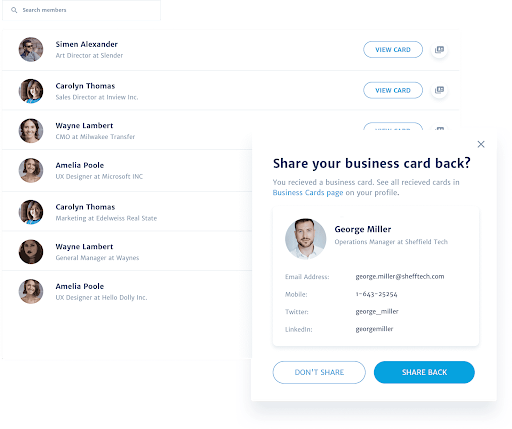
Additionally, your members can create and share their digital cards with their networks thanks to Glue Up’s digital business card exchanges feature.
Community owners fully control how members engage. You can create public or private groups for your members, assign roles to your community teams, and manage access. For instance, you can start a private group with restricted access for paying members that offers more features and functionalities.
Glue Up also offers a community analytics tool that provides immediate insights from collected community data. This helps associations to make smarter decisions that will lead to the community and overall organizational success.
You also don’t have to be worried about keeping all members updated. Glue Up sends a weekly email digest to your members to inform them about what’s happening in the community. The email includes the entire week’s engagement details, including post interactions, events published, and any files uploaded.
Finally, Glue Up helps community managers save time by providing key plug-and-play integrations to software like Salesforce, Quickbooks, and Zoom.
Conclusion
Community analytics is a vital tool that offers multiple benefits. It can help community leaders transform their associations and other member-based organizations into thriving, engaging spaces. One of the key benefits is helping you make data-backed decisions by providing actionable insights into members' interests, needs, and preferences.
A data-driven approach will maximize your community's value while creating meaningful experiences for your members. As discussed above, there are various ways community analytics helps online community leaders make data-driven decisions to drive growth.
Some of them include helping you understand user behavior, generating data for you to enhance user experience on the platform, and identifying user needs and preferences for you to create effective content.
Community analytics also provides insights into potential member conflicts and into the best community growth strategies. With the data from your online community, you can also determine their preferred modes of communication and make the right choice to ensure engagement.
Start monitoring your community analytics today. With the data-driven decisions you make, you’ll create a stronger and more vibrant community geared toward growth.
Author Bio:
By Ashish Gupta, former Tech Lead for Machine Learning at Google AdWords (6 years) and a quant developer on Wall Street. Co-Founder & CEO of Polymer Search, the first no-code solution to make structured data more accessible. His goal is to help anyone extract exactly what is driving their performance metrics or ad spend, at any level of detail, and without special data science knowledge.


